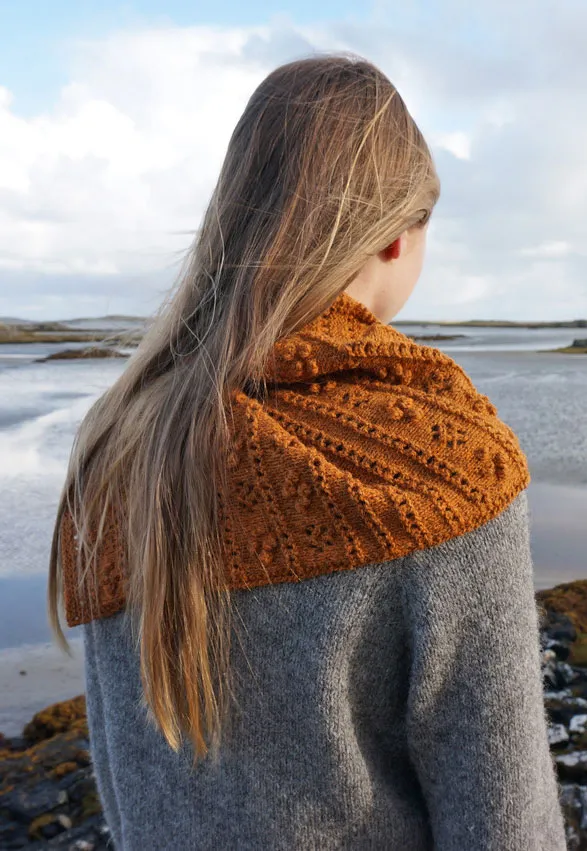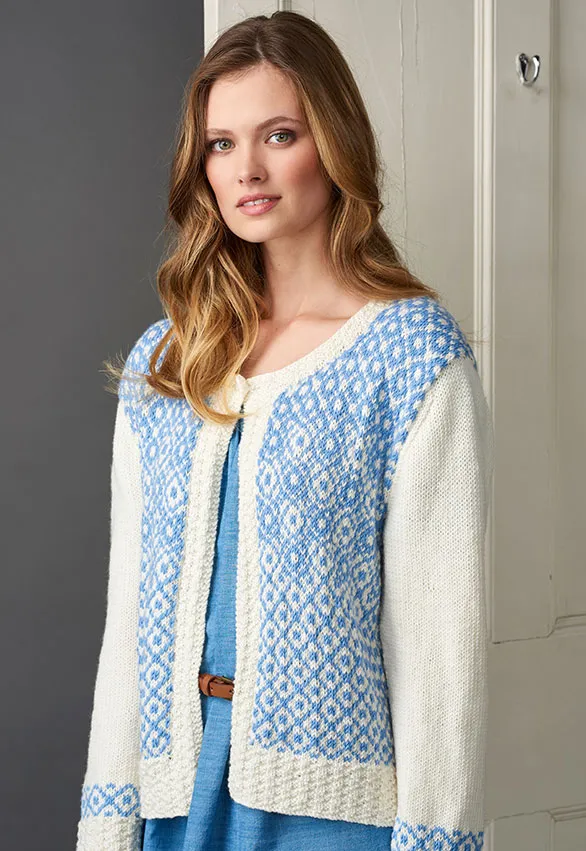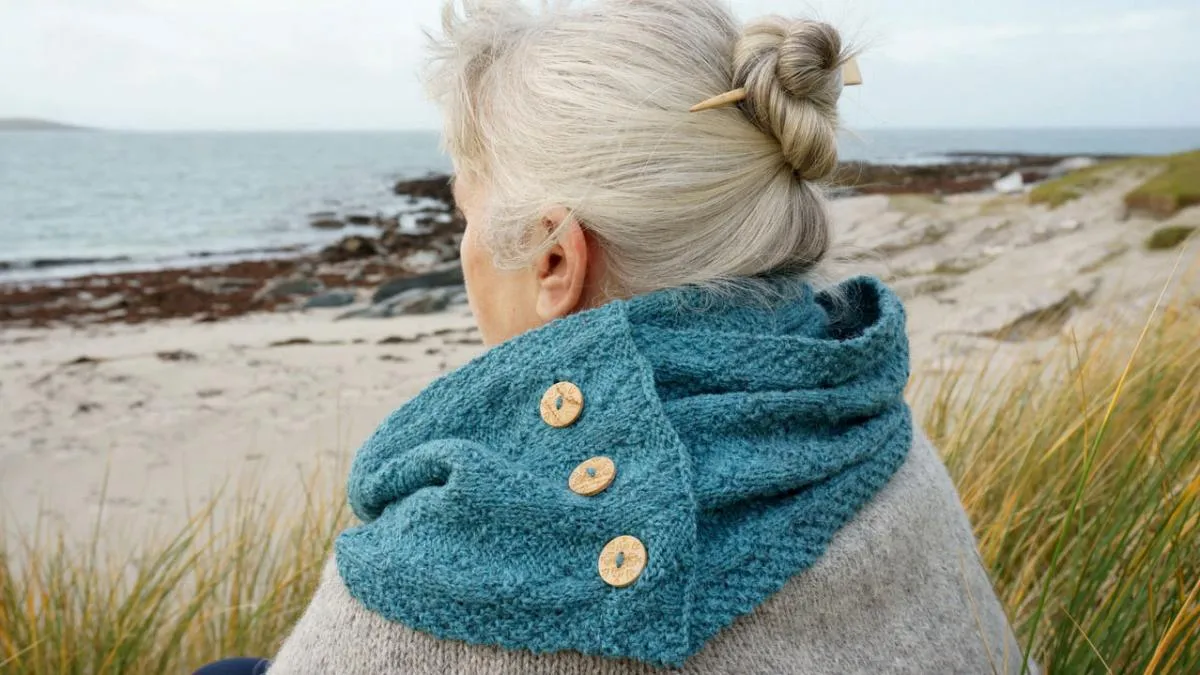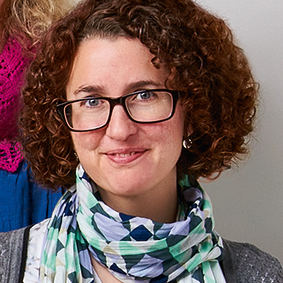Emma Vining is one of The Knitter’s most popular designers, thanks to her incredibly intricate, thoughtful stitch patterns and shapes. She tells us about the people and places that inspire her work.
Who inspired you to take up knitting? "Although I was involved in yarn winding (or tangling!) at my Grandmother's house from a very early age, I first learned to actually knit at home in Glasgow with my Mum and at Primary School in Glasgow.
"Our teacher, Mrs McLean, started us all on simple garter stitch teddy bears and I can still remember the pattern. Once we had mastered these cute bears, my friends and I moved on to fingerless gloves. The glove knitting became very competitive! The pressure was always on to arrive at school wearing a new pair. We all had access to odds and ends of yarn from other projects so there were some amazing colour combinations."

Do you have a favourite artist, writer, poet or musician who inspires you? "There is a wealth of fantastic inspiration to be explored in museums and galleries, from the buildings themselves to all the items on display and in the collections. Throughout my City & Guilds course and for much of my recent design research, I have gained a lot of inspiration from the architecture and objects in the Victoria and Albert (V&A) Museum. This has led me into becoming much more involved with the Museum and I am now very proud to be a V&A Visitor Experience Volunteer.
"The V&A is the hub for the London Design Festival (LDF) that takes place every September and I love finding out about all the temporary installations and the artists who create them. Last year I volunteered to be an LDF guide, taking visitors on tours of all the exhibits. In particular, the artist Ross Lovegrove filled the Tapestry Gallery with an enormous folded structure called 'Transmission'. The artist had been inspired by the folds in the garments of the figures within the fifteenth century Devonshire Hunting Tapestries. This 21m long soft undulating sculpture was made from the man-made textile alcantara, more commonly found on car seats!"
Which knitwear designer has most inspired you, and why? "I have recently been working on an exciting project for the Knitting and Crochet Guild that is inspired by a very special knitter called Gladys Jeskins (1923-1997). The project is called "A Knitter's Journey" and is part of the Guild's 40th (Ruby) anniversary celebrations.
"Gladys Jeskins was a very creative hand knitter who decided to record her own set of stitch patterns on one extremely long sampler. She was aiming for 1,000 different stitch patterns and before she passed away, she had reached 950. The sampler and 17 accompanying handwritten notebooks were donated to the Guild as a work in progress with the stitches still on the needle!
"Using a single stitch pattern from Gladys's sampler as the starting point, designers were asked to create a new pattern. The process of deconstructing a stitch pattern, then putting it back together again in a different way was a fascinating challenge that I really enjoyed. I chose Gladys's pattern number 40 as my starting point and the resulting shawl design will be released by the Guild as part of an e-book in time for the Ruby anniversary celebrations later this year."

Tell us about the colours, landscapes or architecture that inspires your design work. "The stunning landscape of the Outer Hebrides inspired two of my recent designs. My Machair Wildflowers shawl and my Storm Cast cowl patterns were the winning designs in a competition set by The Birlinn Yarn Company (BYC). As well as having my designs made into knitting kits, my prize includes a week on the Isle of Berneray in the Outer Hebrides! My designs for the BYC reflect the owner Meg Rodger's passion for the sea and her love of the Hebridean landscape.
"The Machair Wildflowers shawl uses lace eyelets and raised bobbles to reflect the different stages of the flowers in the wild meadows. The term "Machair" refers to a raised beach area of grassland where due to the nature of the soil, cropping rotation and grazing, there is an abundance of wild flowers. The knitted raised bobble pattern represents these flowers as closed buds and the open flowers are knitted in a lace eyelet pattern.
"My second design, the Storm Cast cowl, was inspired by the sea and waves breaking on the shore. Storm Cast is a long double length cowl fastened by buttons. The textured stitch pattern uses only knit and purl to create a zig zag pattern that crosses the cowl just like the ebb and flow of the tide. The beautiful BYC 4ply yarn is made from the fleece of Meg's seafaring sheep, which are moved by boat between the islands for grazing."

Which design from your portfolio are you most proud of, or is most special to you? "You are asking me to make a difficult choice! I love exploring well known techniques and using them in new ways. For example, the stranded colourwork in my Lisbon Cardigan was inspired by tiles I had seen on a trip to Lisbon, Portugal. Many of the buildings in the city were completely covered in several tile designs. On some buildings there were more than one style and pattern of tile. Where the tiles changed from one pattern to the next created an interesting transition pattern.
"This gave me the idea of changing the background colours in my knitting pattern and making the transition from one shade to a key part of the overall design. This knitted transition was achieved by alternating the background colours across the rows, then changing the order on the next set of repeats.
"Another favourite is my Deveraux sweater. It is knitted in Sublime Lustrous Extra Fine Merino DK, which has a slight metallic sheen. The stitch pattern was inspired by my research into armour. I looked specifically at armour from the early sixteenth century from the Greenwich workshop set up by King Henry VIII. As part of my research, I visited armour collections in many different locations: for example, the V&A in London of course, Kelvingrove Museum and Art Gallery in Glasgow, The Tower of London, The Metropolitan Museum in New York. The London Museums were not too difficult to access and I took my Mum along with me to Kelvingrove Museum in Glasgow. New York was a family holiday and my husband and children were very understanding about spending so much time in the Armoury!"
Are there any techniques, traditions or styles of knitting you'd like to explore further? "As my favourite style of knitting involves everything to do with cables, I am absolutely thrilled to have been commissioned to write a book all about this technique. Twists and cables are an amazing way to create a wide variety of stitch patterns.
"As well as providing a stitch pattern reference, my book will encourage readers to design their own twisted stitch and cable patterns using inspirational sources. I'll be providing lots of ideas about where to look for inspiration for these new designs.
"I am currently working on a series of accessory patterns to highlight all the techniques that I write about in the book. Publication is set for later this year and I can't wait to share the designs with everyone!"
See more of Emma's work on her website, and follow Purlemma on Ravelry, Twitter and Pinterest.



